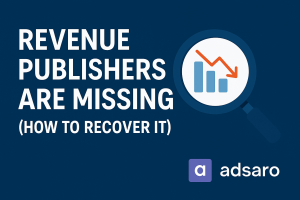Digital advertising runs on data, algorithms, and speed. But as technology evolves, traditional computing systems are struggling to keep up with the rising demand for real-time personalization, instant bidding decisions, and precise user targeting. This is where quantum computing enters the picture—not as an incremental improvement, but as a radical shift.
Quantum computing, with its potential to process exponentially more data at once, could transform the very backbone of advertising technology (ad tech). In this blog, we’ll explore how quantum computing may impact ad tech by diving into the future of targeting, personalization, fraud prevention, predictive analytics, and privacy.
What Is Quantum Computing?
Quantum computing uses quantum bits (qubits) instead of classical bits. These qubits can represent 0 and 1 at the same time—a property called superposition. They can also be linked via entanglement, allowing them to interact in ways that classical computers cannot replicate.
This allows quantum computers to solve highly complex problems by exploring all possible solutions at once, making them exponentially more powerful than traditional machines. In ad tech, where decisions happen in microseconds and vast datasets must be analyzed in real-time, this type of power could be a game-changer.
The Role of Data in Ad Tech
Ad tech is inherently data-driven. Every ad impression, every user click, every scroll or pause on a screen generates data. Platforms use this information to make automated, split-second decisions about which ad to serve to which user.
However, with growing data volumes and increasingly complex ad ecosystems, traditional computing systems are hitting performance ceilings. Bottlenecks in data analysis, latency in decision-making, and constraints in personalization limit how effective campaigns can be. This is where quantum computing could inject unprecedented speed and intelligence.
1. Hyper-Accurate Targeting and Personalization
Currently, most targeting in advertising is based on basic demographics, past behaviors, or cookies. But this approach has its limitations—it often relies on generalized audience segments and historical data that doesn’t always reflect real-time user behavior.
Quantum computing can dramatically improve this by enabling platforms to:
- Analyze massive volumes of user data (including unstructured data like video and voice)
- Identify hidden patterns and micro-segments
- Adjust ad delivery in real-time based on live user interactions
This level of intelligence allows for deep personalization—not just based on who a user is, but how they feel, what their intent is, and what they’re most likely to respond to at that moment. The result? Ads that don’t just follow users—they connect with them.
2. Real-Time Bidding Optimization
Real-time bidding (RTB) is the heartbeat of programmatic advertising. Every time a user loads a page, ad platforms conduct lightning-fast auctions to determine which ad appears. But even the best RTB engines today must simplify bidding decisions to fit within tight timeframes—meaning many contextual signals are ignored.
Quantum computing could revolutionize RTB by:
- Evaluating more variables per bid, including user behavior, weather, device, location, and time of day
- Calculating optimal bid prices with incredible precision
- Making decisions across multiple ad exchanges simultaneously
With this, advertisers can optimize every bid at a deeper level, ensuring cost-efficiency and higher conversion potential without sacrificing speed.
3. Fraud Detection and Prevention
Ad fraud is a multibillion-dollar problem. Fraudsters use bots, fake traffic, and click farms to siphon ad spend. Detecting this fraud in real-time is challenging because it often involves subtle patterns across large datasets.
Quantum computing offers an edge by:
- Rapidly identifying statistical anomalies in ad traffic
- Comparing massive historical datasets to spot suspicious trends
- Deploying machine learning models that evolve faster and adapt better
This could lead to proactive fraud prevention, enabling advertisers to protect budgets and ensure ad quality before fraud even happens.
4. Enhanced Predictive Analytics
Predictive analytics helps advertisers make informed decisions about campaigns—what creative works best, when to serve ads, how to allocate budgets, etc. But today’s models are limited by computing power.
Quantum computing could take predictive analytics to the next level by:
- Running thousands of simulations at once using quantum machine learning
- Modeling user behavior across multiple future scenarios
- Offering dynamic recommendations as campaign conditions change
Imagine being able to forecast the ROI of every creative variation, or instantly adjust a media plan based on evolving user behavior—that’s the power of quantum-enhanced advertising intelligence.
5. Privacy-First Personalization
As laws like GDPR and CCPA become stricter, advertisers face the challenge of delivering personalization without invading privacy. Most current methods rely on personally identifiable information (PII) or third-party cookies—which are being phased out.
Quantum computing offers solutions in the form of:
- Quantum encryption for anonymized yet secure data use
- Secure data collaboration models (e.g., clean rooms) where brands can access insights without accessing raw user data
- Privacy-preserving personalization based on aggregated behavior models
This enables brands to respect user privacy while still offering relevant, personalized ad experiences—a win-win for ethics and performance.
Challenges and Limitations of Quantum Computing
Despite its promise, quantum computing isn’t plug-and-play. Here’s why adoption will take time:
- Quantum hardware is still highly experimental and costly
- Quantum algorithms must be developed for specific advertising use cases
- There’s a talent gap in the field—few ad tech engineers are trained in quantum theory
- Integration with existing platforms (DSPs, SSPs, CDPs) requires significant architectural changes
However, industry leaders like IBM, Google, and Amazon are heavily investing in quantum, signaling that ad tech’s quantum moment may arrive sooner than expected.
Conclusion
Quantum computing has the potential to fundamentally reshape how digital advertising works. From real-time data analysis to fraud detection, personalized targeting, and privacy-focused innovation, its power could unlock new levels of performance and efficiency.
While it may take a few more years before quantum becomes mainstream in ad tech, early adopters stand to benefit the most. Advertisers, publishers, and platforms that begin preparing now—through research, experimentation, and partnerships—will be ready for a new era of quantum marketing where personalization is perfect, bidding is bulletproof, and fraud is nearly extinct.








Leave a Reply